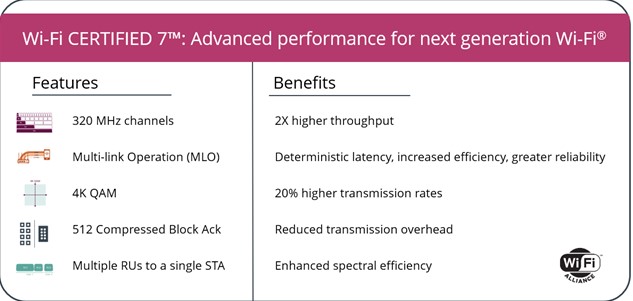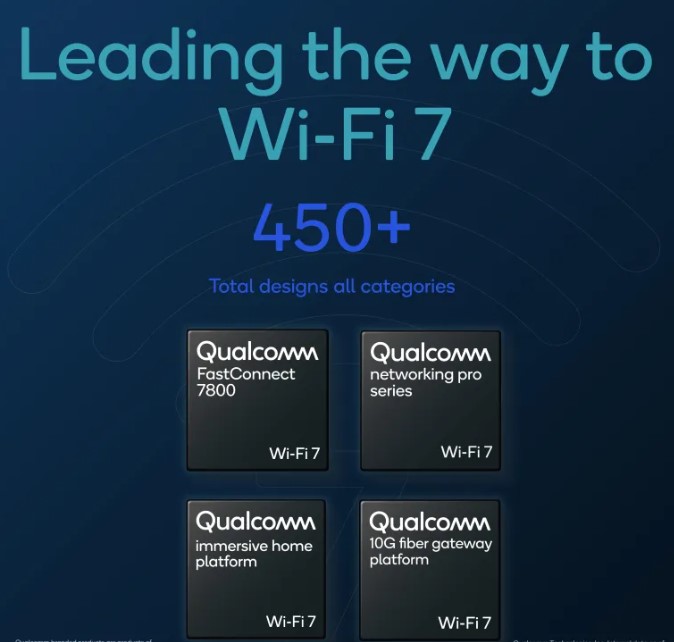Wi-Fi Alliance launches Wi-Fi CERTIFIED 7
The Wi-Fi 7 Alliance’s Wi-Fi CERTIFIED 7 certification program sees a rapid influx of new chip and IP announcements.
Wi-Fi CERTIFIED 7 is a recently launched industry certification program developed by the Wi-Fi Alliance and a network of member companies. The program establishes Wi-Fi 7 device adherence to stringent standards for enhanced performance, seamless connectivity and interoperability worldwide. Wi-Fi 7 addresses today’s realities of increased network congestion and the burgeoning consumer demand for 4K and 8K video, electronic gaming, immersive 3D, generative AI, remote health monitoring and in-home IoT devices.
Wi-Fi 7 supports immersive and bandwidth-intensive applications for home and enterprise environments and delivers benefits in the areas of throughput, efficiency, latency and power consumption. Improvements include doubling the throughput of Wi-Fi Certified 6, higher transmission rates via 4K QAM modulation and multi-link operation (MLO).
What is Wi-Fi 7?
Wi-Fi 7 (IEEE 802.11be) is the newest generation of Wi-Fi that delivers an extremely high throughput, deterministic low latency and increased network capacity. It is designed to enable immersive and content-rich applications such as XR, gaming, 4K/8K streaming and real-time collaboration. New technology improvements include:
Ultra-wide 320-MHz channels: Enables 6-GHz access and doubles the throughput (transmission capacity) of Wi-Fi 6/6E for multi-gigabit Wi-Fi device speeds.
MLO: Allows devices to connect simultaneously on two bands to deliver high performance even in congested environments, delivering higher throughput, lower latency and higher reliability.
Modulation to 4K QAM: Achieves 20% higher transmission rates than 1024 QAM for Wi-Fi 6.
Multiple resource units (RUs) to a single statin (STA): Improves flexibility for spectrum resource scheduling to enhance spectrum efficiency.
The Wi-Fi CERTIFIED 7 program boosts performance and fast-tracks greater connectivity across a variety of environments and use cases including multi-user AR/VR/XR, immersive 3-D training, electronic gaming, hybrid work, industrial IoT and automotive. Several companies, including Broadcom, CommScope RUCKUS Networks, Intel, MaxLinear, MediaTek and Qualcomm participate in the test bed for certification and are among the first with certified products.

Qualcomm and Wi-Fi 7 Certification
Wi-Fi 7 introduces powerful new features that boost Wi-Fi performance and improve connectivity across a variety of environments. Qualcomm Technologies, Inc. is among the first to achieve this certification and drive the transition to Wi-Fi 7.
As of January 2024, Qualcomm has announced more than 450 Wi-Fi 7 designs launched or in development. These include 200+ mobile, compute and XR designs based on FastConnect 7800 Mobile Connectivity System and 250+ Wi-Fi networking designs based on the Networking Pro Wi-Fi 7, Immersive Home Platform and 10G Fiber Gateway Platform.

Qualcomm’s implementation of multi-link technology is at the heart of realizing performance gains, including its multi-link client implementation called High Band Simultaneous Multi-Link (HBS Multi-Link) and mesh Wi-Fi networking with its Multi-Link Mesh technology. The company’s modular and scalable Wi- Fi 7 platform architectures address design requirements and set new industry benchmarks for networking performance by delivering wireless capacity of up to 33 Gbits/s. When paired with 5G fixed wireless access, 10G-PON fiber and advanced cable protocols, these Wi-Fi 7 platforms deliver next-generation connectivity.
Wi-Fi 7 chips and IP
In addition to Qualcomm, several companies are supporting the effort with new chip and IP announcements. These include MaxLinear, MediaTek and Ceva.
MaxLinear, Inc. announced the certification of its Wi-Fi 7 chipsets and Tri-band Access Point and its selection as one of the Wi-Fi CERTIFIED 7 test bed devices. The test bed uses MaxLinear’s Tri-band Access Point product with three frequency bands (2.4 GHz, 5 GHz and 6GHz), using MaxLinear’s single Wi-Fi SoC. According to the company, the Wi-Fi CERTIFIED 7 Access Point improves speed, capacity and efficiency, all important in high-density environments. The access point features include 4K QAM, MLO, Multi RU and puncturing, MU-MIMO, OFDMA, advanced beamforming and power-saving enhancements.
MediaTek Inc. launched the first wave of Wi-Fi CERTIFIED 7 products to provide a fast and reliable network with the connectivity necessary for the latest AI tools. The devices, powered by its Filogic Wi-Fi CERTIFIED 7 chipsets, include a range of consumer and enterprise applications such as residential gateways, mesh routers, televisions, streaming devices, smartphones, tablets and laptops.
The company is providing testbeds for devices on both the access point and client sides, streamlining the product certification process for manufacturers. Chipsets include the Filogic 880, 860, 380 and 360.
Ceva, Inc. extended its Connect IP portfolio with the Wi-Fi 7 platform for high-end consumer and industrial IoT applications including gateways, TVs, set-top-boxes, streaming media devices, AR/VR headsets, personal computing and smartphones. Announcing the general release of its RivieraWaves Wi-Fi 7 IP platform, it provides a comprehensive 802.11be MAC and PHY solution for integration into the next generation of Wi-Fi SoC products.
The IP platform, with all the features of the Wi-Fi 7 wireless standard, simplify the development and time-to-market for companies looking to add Wi-Fi 7 connectivity to their products, Ceva said.
The RivieraWaves Wi-Fi 7 IP platform enables semiconductor companies and OEMs to develop differentiated, high-performance Wi-Fi 7 chipsets for their connectivity roadmaps with lower risk and cost of ownership. It is already available for access point applications, with an optimized station implementation expected this year.
All indications point to rapid adoption of Wi-Fi 7. The Wi-Fi Alliance expects the certification program to support the broad adoption of the technology.
“Wi-Fi 7 will see rapid adoption across a broad ecosystem with more than 233 million devices expected to enter the market in 2024, growing to 2.1 billion devices by 2028,” the group said. Initially, applications will target smartphones, PCs, tablets, access points, customer premises equipment and AR/VR equipment.
Wi-Fi 7 supports full backward compatibility for seamless compatibility between new Wi-Fi 7 devices and legacy devices. When adopted, Wi-Fi 7 will provide faster speeds, dramatically improved responsiveness, higher reliability, secure connectivity and low latency. The final approval of IEEE 802.11be is scheduled in December 2024.
